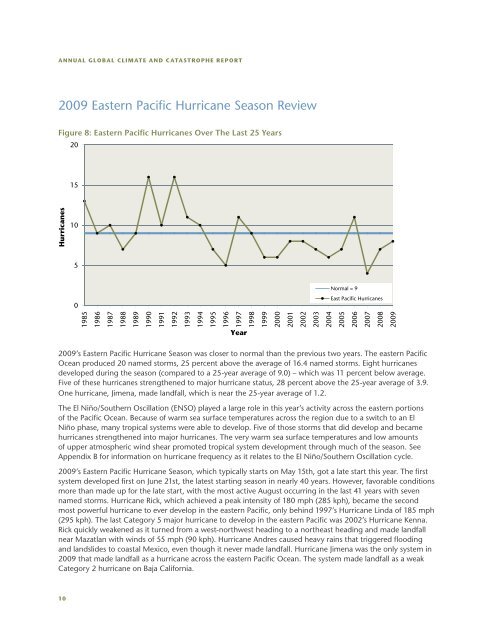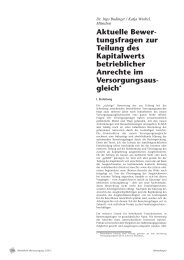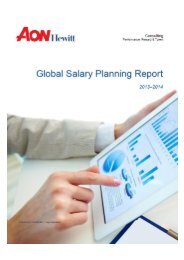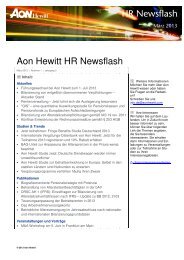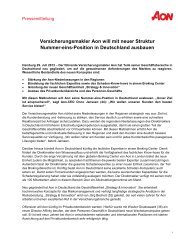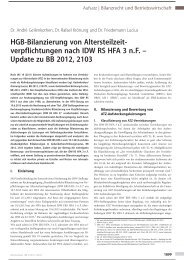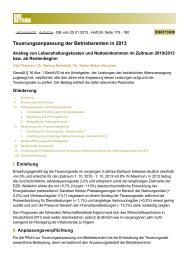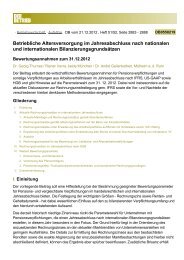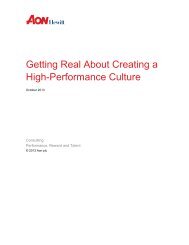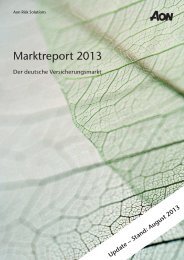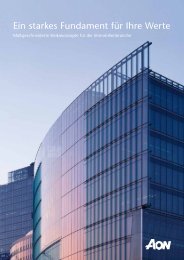Annual Global Climate and Catastrophe Report: Impact ... - Aon
Annual Global Climate and Catastrophe Report: Impact ... - Aon
Annual Global Climate and Catastrophe Report: Impact ... - Aon
You also want an ePaper? Increase the reach of your titles
YUMPU automatically turns print PDFs into web optimized ePapers that Google loves.
AnnuAl GlobAl Cli mAte And C AtAstroph e r e port<br />
2009 Eastern Pacific Hurricane Season Review<br />
Figure 8: Eastern Pacific Hurricanes Over The Last 25 Years<br />
20<br />
Hurricanes<br />
2009’s Eastern Pacific Hurricane Season was closer to normal than the previous two years. The eastern Pacific<br />
Ocean produced 20 named storms, 25 percent above the average of 16.4 named storms. Eight hurricanes<br />
developed during the season (compared to a 25-year average of 9.0) – which was 11 percent below average.<br />
Five of these hurricanes strengthened to major hurricane status, 28 percent above the 25-year average of 3.9.<br />
One hurricane, Jimena, made l<strong>and</strong>fall, which is near the 25-year average of 1.2.<br />
The El Niño/Southern Oscillation (ENSO) played a large role in this year’s activity across the eastern portions<br />
of the Pacific Ocean. Because of warm sea surface temperatures across the region due to a switch to an El<br />
Niño phase, many tropical systems were able to develop. Five of those storms that did develop <strong>and</strong> became<br />
hurricanes strengthened into major hurricanes. The very warm sea surface temperatures <strong>and</strong> low amounts<br />
of upper atmospheric wind shear promoted tropical system development through much of the season. See<br />
Appendix B for information on hurricane frequency as it relates to the El Niño/Southern Oscillation cycle.<br />
2009’s Eastern Pacific Hurricane Season, which typically starts on May 15th, got a late start this year. The first<br />
system developed first on June 21st, the latest starting season in nearly 40 years. However, favorable conditions<br />
more than made up for the late start, with the most active August occurring in the last 41 years with seven<br />
named storms. Hurricane Rick, which achieved a peak intensity of 180 mph (285 kph), became the second<br />
most powerful hurricane to ever develop in the eastern Pacific, only behind 1997’s Hurricane Linda of 185 mph<br />
(295 kph). The last Category 5 major hurricane to develop in the eastern Pacific was 2002’s Hurricane Kenna.<br />
Rick quickly weakened as it turned from a west-northwest heading to a northeast heading <strong>and</strong> made l<strong>and</strong>fall<br />
near Mazatlan with winds of 55 mph (90 kph). Hurricane Andres caused heavy rains that triggered flooding<br />
<strong>and</strong> l<strong>and</strong>slides to coastal Mexico, even though it never made l<strong>and</strong>fall. Hurricane Jimena was the only system in<br />
2009 that made l<strong>and</strong>fall as a hurricane across the eastern Pacific Ocean. The system made l<strong>and</strong>fall as a weak<br />
Category 2 hurricane on Baja California.<br />
10<br />
15<br />
10<br />
5<br />
0<br />
1985<br />
1986<br />
1987<br />
1988<br />
1989<br />
1990<br />
1991<br />
1992<br />
1993<br />
1994<br />
1995<br />
1996<br />
1997<br />
Year<br />
1998<br />
1999<br />
2000<br />
2001<br />
2002<br />
2003<br />
Normal = 9<br />
East Pacific Hurricanes<br />
2004<br />
2005<br />
2006<br />
2007<br />
2008<br />
2009


